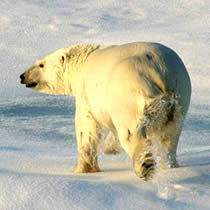
 |
 |
Global Warming Affecting Alaska Polar BearsNovember 15th, 2006University of Wyoming - A new report says that fewer polar bears cubs are surviving in the south Beaufort Sea off Alaska's northern coast. 
Researchers for the first time have shown a connection between global warming and decreased polar bear survival, says a University of Wyoming scientist. Eric Regehr, a UW Ph.D. candidate in zoology and physiology and United States Geological Survey (USGS) employee, has spent the last two years analyzing polar bear data collected by the Canadian Wildlife Service in Canada's western Hudson Bay. "These data provide evidence for a direct linkage between reduced sea ice coverage, presumably caused by climate change, and decreased polar bear survival in western Hudson Bay," Regehr says in the current edition of UWyo magazine. The Canadian Wildlife Service study documents a 22 percent decline in the size of the western Hudson Bay polar bear population, from 1,194 in 1987 to 935 in 2004. Although researchers cannot determine the degree to which legal polar bear harvesting by Canadian Inuit has affected the population, they agree changing sea ice is partly to blame. U.S. polar bears are found only in northern Alaska where, to date, USGS research has not linked global warming to changing population dynamics, according to Regehr and his colleague, George Durner, another UW Ph.D. candidate who has worked with the USGS on polar bear research for 14 years. Western Hudson Bay is near the southern limit of polar bears' range. As such, USGS researchers say findings in that region may foreshadow how more northern polar bear populations (specifically those in Alaska) could respond if the Arctic continues to warm as predicted by climatologists. Although caution must be taken in extrapolating the Canadian study to other polar bear populations, U.S. conservation groups already are using the information to urge federal regulatory agencies to consider regional ramifications if climate change does affect American polar bears. Last February the U.S. Fish and Wildlife Service (USFWS) acknowledged a petition by the Center for Biological Diversity, Natural Resources Defense Council, and Greenpeace to seek federal protections for the polar bears. The petition is still under review, but has been validated by the USFWS, which says the petition contains enough research support to be given serious consideration. Before protecting U.S. polar bears under the Endangered Species Act, the USFWS must seek specific information regarding population distribution, habitat, and effects of climate change on both the polar bears and their prey, along with the potential effects of development, contamination, and poaching threats. While a variety of polar bear research projects are consulted, the USGS will provide much of the information for the USFWS ruling, according to Durner. "Our purpose at USGS is to provide the best scientific data that the regulatory agencies may use to make their decision. Our information may suggest that polar bears should be listed as a threatened species, or it may not. We don't know yet how that is going to turn out," he says. Durner's research focuses on how free-ranging polar bears in Alaska use sea ice and how that varies during the course of the year. The world's largest terrestrial carnivores, polar bears spend most of their lives on sea ice. The bears are completely dependent upon the ice for their survival, including access to their primary prey, seals. Although Durner has not detected a change from the late 1990s to today in how polar bears are using sea ice in his specific Arctic research area, he says USGS models elsewhere in Alaska have indicated that ice conditions have changed and polar bears may be using ice differently than they have in the past. Unlike Alaska's sea ice environment, the sea ice in Hudson Bay melts completely for three to four months each year and forces the animals on shore without food. Researchers say earlier melting of sea ice may also explain why in recent years there has been an increase in human interactions with polar bears in communities along the western coast of Hudson Bay, such as Churchill, Manitoba. "As polar bears become more nutritionally stressed due to changing sea-ice conditions, they have become more likely to come into town to look for food," Regehr says. While the majority of Alaskan polar bears do not spend the summer on land or among human habitats, the recent trend toward a longer ice-free season off Alaska's northern coast has forced polar bears from the biologically-productive waters over the continental shelf to the deep, offshore regions where prey may be more limited, Durner says. "I think polar bears are in many ways very flexible in that they seem to adjust to certain conditions, but they can only do that to a certain point," Durner says. "There may come a point where ice conditions change so much that polar bears will not be able to compensate, and we're going to see effects of nutritional stress in the population, represented in lower survival of certain age groups [juvenile, sub-adult, and aging adult], which ultimately would affect polar bear population status in Alaska." Regehr adds, "A major focus of both George and my graduate studies here at the University of Wyoming is to try and understand whether these environmental changes are affecting polar bears (in Alaska), and if so, what that future might hold for these incredible animals." © From a University of Wyoming Press Release |
|